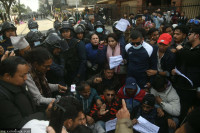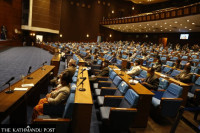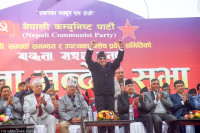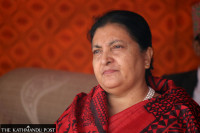Politics
Aam Aadmi’s resounding win in Delhi could be a lesson for Nepal’s alternative political forces
AAP’s win has been attributed to connecting with the people at the grassroots, which Nepal’s alternative forces have failed to do, political analysts say.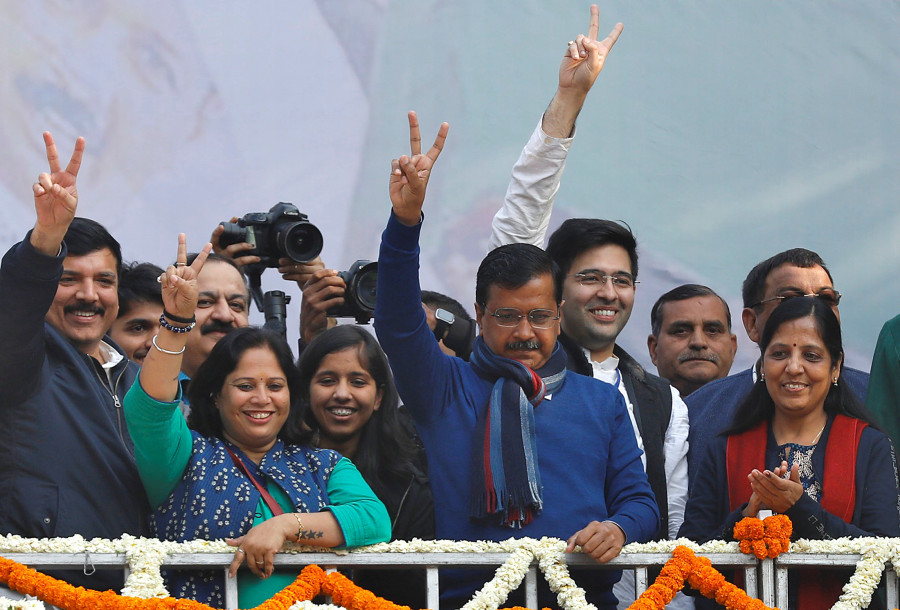
Binod Ghimire
On Wednesday morning, Sajha Party coordinator Rabindra Mishra posted a message on Twitter congratulating Arvind Kejriwal, chief of India’s Aam Aadmi Party, for his third consecutive victory in the Delhi elections.
“You are an inspiration to an alternative party like ours (@Sajha_Party) in Nepal, which like @AamAadmiParty, also believes in anti-corruption, welfarism and good governance,” Mishra wrote.
Nepali Twitter users were quick to respond, with some even taking a dig at Mishra and his party. A few, however, pointed out the reasons for Kejriwal’s win in Delhi and urged Mishra to follow suit if he wishes to emerge as a viable alternative force in the country.
“The lesson from Delhi poll results –work on concrete agenda, formulate new education model [making government schools better than private], differentiate from mainstream parties [avoid allegations],” said one user Babin Bhandari—@bhandaribabin.
Since quitting his BBC job and forming the Sajha Party in 2017, Mishra has been accustomed to derision and criticism, often on social media platforms. When he decided to make his foray into politics, he said that he believed that the people who were ‘frustrated’ with the mainstream parties—particularly their way of politics—would vote for his party. He believed that people in Nepal are looking for an alternative force.
From the very beginning, it was evident that the Sajha Party largely drew inspiration from Kejriwal’s Aam Aadmi, or Common Man, Party. But unlike Kejriwal’s party, Sajha Party, in its three years of operation, has not managed to achieve much, winning no seats at the national level. But Mishra has appeared unfazed. In an interview with the Post in November, Mishra said that he still believed he could make his party number one in the country.
Political analysts, however, say wanting something to happen and making it happen are two different things, as those who call themselves alternative forces lack an ‘alternative’ ideology.
“A party that wants to become like the AAP should understand that it didn’t come to power overnight without doing anything,” Puranjan Acharya, a political analyst who was an aide to former prime minister Girija Prasad Koirala, told the Post.
Kejriwal has landed in controversy, mostly due to his failure to deliver, but over the years, he has managed to make a case for himself and the need of an alternative party.
For years, he championed the right to information and the anti-corruption movement. Even when he was an officer with the Indian Revenue Service, Kejriwal assisted Parivartan, an organisation that worked to ensure the right to information. After resigning from government service, he, along with Manish Sisodia and Abhinandan Sekhri, co-founder of newslaundry.com, established the Public Cause Research Foundation in December 2006 which campaigned for transparent, accountable and participatory governance.
Starting in 2o11, he was involved in the India Against Corruption, a movement which campaigned for the Jan LokPal Bill, under the leadership of Anna Hazare.
The AAP was formed in November 2012 and contested the Delhi Assembly election a year later. Kejriwal became chief minister only for 49 days as his party didn’t have a majority. But the party swept the election in the next assembly polls in 2015, winning 67 seats in the 70-strong assembly.
On Wednesday, Kejriwal’s AAP scored a hat-trick and won again, stunning India’s governing Bharatiya Janata Party. AAP now has 62 seats, won largely on the basis of its delivery on basics, like reliable electricity and water supply and improvements to health and education.
It’s evident from AAP’s win in Delhi that parties need to win the hearts of the people by raising issues of social justice and development rather than professing lofty ideologies, say analysts.
“Calling oneself an alternative force doesn’t make it so,” said Rajendra Maharjan, a writer and political commentator. “That has to be reflected in action.”
According to Maharjan, those who call themselves alternative forces or those who want to become alternative forces are neither clear on ideology nor on the agenda.
Even former Maoist leader Baburam Bhattarai had broken away from the Maoists to form his own party—Naya Shakti, meaning “new force”. Bhattarai argued that the Nepali people were in desperate need of an alternative new force, but the party failed to gain traction. Bhattarai’s Naya Shakti had just one seat each in the House of Representatives and the Bagmati Provincial Assembly.
Last year, Naya Shakti merged with the Sanghiya Samajbadi Party to form Samajbadi Party and Bhattarai’s refrain of providing an alternate force has continued. But it is evident that the party is struggling to convince the people about its ideology and agenda.
“Nepal’s aspiring alternative parties have a host of issues to talk about—roads, transportation, corruption, pollution and water supply, to name a few. That’s how they can connect with the people and become the voice of the people,” said Maharjan. “The parties that wish to become Nepal’s AAP need to seriously revisit their working styles.”
It’s not that Mishra’s party does not have its presence felt at all. Its focus has been urban centres, where it has performed relatively well for such a young party.
A few months before the federal parliament and provincial assembly elections, Mishra, in July 2017, had merged his party with the Ujwal Thapa-led Bibeksheel Nepali, another party that claims to be an alternative force. The unified party failed to win a single seat under the first-past-the-post system for federal Parliament and provincial assemblies. It was only able to garner three seats in the Bagmati Provincial Assembly under proportional representation.
Acharya, the political analyst, said that for an alternative party, or any party for that matter, to be recognised, it needs to connect with the people.
The new parties need to look at the history of the Nepali Congress and other parties, he said.
“The Nepali Congress was born out of a labour movement in the Biratnagar Jute Mill,” Acharya told the Post. “Similarly, the CPN-UML had a history of the Jhapa revolution while the Maoist party came into mainstream politics after launching an insurgency from a remote place like Rolpa.”
According to Acharya, there is always space for alternative forces, but they need to change their working style and get out of their comfort zone.
Leaders of the ‘alternative’ parties agree that they haven’t been able to connect to the people.
Surya Raj Acharya, spokesperson for the Sajha Party, said that they understand that raising their voice through social media alone is not enough.
“We have learnt that we need to connect to the people from the grassroots to build a strong base as a party,” said Acharya. “We have to change our way of functioning, and we will.”
Bibeksheel Nepali, which has been involved in politics since the second Constituent Assembly elections in 2013, also said that they are raising the voice of the people to the extent they can.
“We will show what we can do once we get the authority when we are elected,” said Ranju Darshana, a Bibeksheel leader. “However, a lot needs to be done to win the people’s confidence to get that position. We will, through creative ideas, try to connect with the people in a better way.”




 18.12°C Kathmandu
18.12°C Kathmandu
